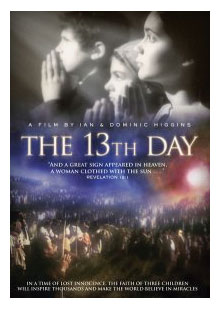
THE 13th DAY
110 minutes, Black and white and Colour.
Filipa Fernandez, Jane Lesley, Michael D' Cruze, Tarek Merlin.
Directed by Ian and Dominic Higgins.
This is a film about the experience of the three young children, Lucia, Jacinta and Francisco, who had visions of the Blessed Virgin Mary in Fatima, Portugal, in 1917.
Another film about the apparitions was made in 1953, The Miracle of Our Lady of Fatima, directed by John Brahm. It was quite a devout film in the vein of The Song of Bernadette, made ten years earlier. The Fatima film is not in the dramatic quality of The Song of Bernadette. In 1953, with the Mc Carthy hearings, the blacklist and a strong anti-Communist atmosphere in the United States, the Fatima film was strong in dialogue critical of Communism.
The present film, released in 2009, retains the atmosphere of anti-communism, commenting on the Bolshevik revolution of 1917, the spread of world communism, the consequences for the world and the atheistic communism and persecution of the church.
The film was made for video release, especially to devout audiences who were comfortable with the language of devotion and piety. In does not play well to those who don’t share the faith perspective or the piety perspective.
The film opens with the older girl, Lucia, in a convent in Spain in 1937, asked to write her memoirs. The sequences recur throughout the film, with the film ending looking directly at Lucia.
The action of the film is principally in flashback. Most of the film is made in black and white, with special effects for colour pervading some of the sequences, especially with the presence of the Blessed Virgin Mary, colour for the three visionaries, on some of the thousands who gathered to witness the children and their apparitions, but, especially the famous dance of the Sun on October 13, 2017. The writers and directors of the film, brothers Ian and Dominic Higgins, were also in charge of these special effects. This makes the experience of the film more striking than it might have been.
The rest of the film is fairly conventional, one of the mothers being very hostile to the idea of her child having visions while the father is sympathetic. There are some moments with the parish priest, his interrogations, his questioning and disbelief – and his later being surprised at the effects of the apparitions.
There is great emphasis on the political atmosphere of the time, especially in Portugal and its anti-clerical government, the response to the apparitions and the internment of the children, the crude death threats, the fear of people’s reactions. There are glimpses of the Bolshevik revolution and so the attitudes of the times, very wary of communism, after the war.
The spirituality of the apparitions is rather grim, an offended God, suffering for saving the souls of sinners.
The apparitions continued monthly from May to October, 1917. Lucia lived until the year 2005. Jacinta and Francisco succumbed to the influenza epidemic after the war.
1. The audience for this film, believers, Catholics, the devout?
2. The black-and-white photography, celebrates silhouettes and posed scenes? Idyllic? The transition to colour, for the apparitions, for Mary, the children? The miracle of the Sun?
3. The voice-over, Lucia, 1937, her writing? Her introducing the other two children, the ideal description of them?
4. The background World War I, the Bolshevik revolution, anticlerical government in Portugal?
5. The children out of the hills, playing, the storm, the stillness of the air, the mission? The lady, talking about suffering, saving sinners, the children’s willingness to do this?
6. Response of the parents, the mother thinking it was the wrath of God? The sympathetic father?
7. The parish priest, the interrogation, the children not revealing the secrets? The later challenge to his attitudes?
8. The torment of the children, the populace, at school, considered a witch, the children’s response to save souls?
9. The return to the apparitions, the crowds? Journalists? The authorities and their response?
10. July, their being interned? The ground splitting, the colour version of the fires of hell?
11. Mary, the immaculate heart, wanting a consecration of Russia to the immaculate heart? That the Pope was to suffer – the visual of the Pope?
12. The accusation that the children were making up fairytales? In their internment, the crass threats of death, boiling oil? The other prisoners, praying the
rosary?
13. October, the people critical, the dancing Sun? The effect on people?
14. The secrets, and spirituality of God being angered, Mary’s tender sorrow, parents and reparation?
15. The value of having this kind of dramatisation of the experience of Fatima?